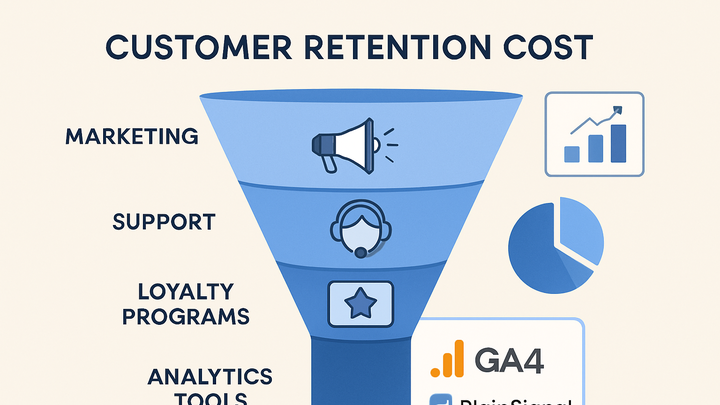Published on 2025-06-26T04:48:26Z
What Is Customer Retention Cost? Definition, Calculation, and Examples
Customer Retention Cost (CRC) is the total sum of all activities and expenses a company invests to keep existing customers engaged, satisfied, and making repeat purchases. This includes marketing campaigns, loyalty programs, customer support, and the underlying technology infrastructure that powers engagement. By measuring CRC, businesses can benchmark how much they spend to retain a customer versus the revenue that customer generates over time. In analytics, CRC helps teams identify cost‐inefficient channels, optimize resource allocation, and improve customer lifetime value (CLV). Platforms like Google Analytics 4 (GA4) and cookie-free solutions such as PlainSignal make it easier to track retention events, attribute costs accurately, and refine strategies through cohort analysis.
Customer retention cost
Total cost invested in retaining existing customers, including marketing, support, loyalty programs, and analytics expenses.
Importance of Customer Retention Cost
Understanding CRC is vital because retaining an existing customer typically costs far less than acquiring a new one. High retention costs can erode profit margins, while optimized retention drives sustainable growth. Tracking CRC provides a clear view of which initiatives yield the best ROI and informs strategic budget allocation.
-
Cost efficiency
Studies show retaining a customer can cost up to five times less than acquiring a new one. Monitoring CRC highlights which retention tactics deliver the greatest savings.
-
Profitability impact
Lower CRC directly increases net profit per customer. Comparing CRC to Customer Lifetime Value (CLV) reveals whether retention programs are delivering a positive return.
Calculating Customer Retention Cost
CRC aggregates all expenses dedicated to keeping customers over a defined period. By dividing total retention spend by the number of retained customers, businesses pinpoint cost drivers and optimize budgets accordingly.
-
Basic formula
CRC = Total Retention Expenses ÷ Number of Retained Customers. Retention expenses include marketing campaigns, loyalty program costs, customer support, and technology fees.
-
Marketing spend
Costs for email, SMS, social media, and ad campaigns targeting existing customers.
-
Loyalty programs
Expenses for rewards, discounts, referral bonuses, and tiered benefits.
-
Customer support
Salaries, software licenses, training, and infrastructure for support teams.
-
-
Time frame considerations
Select consistent windows (e.g., monthly, quarterly, annually) to compare CRC over time. Short windows may produce volatile results, while longer windows smooth trends.
-
Common pitfalls
Failing to include indirect costs—like platform subscriptions or development time—can understate true CRC and lead to misguided decisions.
Measuring CRC with Analytics Tools
Analytics platforms automate the tracking of retention events, cost attribution, and visualization of key metrics. Here’s how to use GA4 and PlainSignal for CRC measurement:
-
Google analytics 4 (GA4)
GA4 tracks returning users and engagement metrics out-of-the-box. You can import cost data via Data Import or BigQuery, then build custom reports to calculate CRC per channel and campaign.
-
PlainSignal cookie-free analytics
PlainSignal offers privacy-centric, cookie-free tracking with simple retention reporting. To integrate:
-
Integration code
Insert the following snippet into the <head> of your HTML to start tracking:
-
Code example
<link rel="preconnect" href="//eu.plainsignal.com/" crossorigin /> <script defer data-do="yourwebsitedomain.com" data-id="0GQV1xmtzQQ" data-api="//eu.plainsignal.com" src="//cdn.plainsignal.com/plainsignal-min.js"></script>
-
Strategies to Optimize Customer Retention Cost
To lower CRC while boosting loyalty, focus on high-impact, scalable tactics and continuous improvement. Below are proven strategies:
-
Personalization at scale
Use behavioral segmentation to deliver tailored offers and content, increasing engagement without proportional spend increases.
-
Automated retention campaigns
Implement triggers—like cart abandonment or milestone anniversaries—to send timely messages with minimal manual effort.
-
Data-driven loyalty programs
Analyze redemption patterns and customer feedback to refine tiers, discounts, and reward structures for maximum cost efficiency.
Best Practices and Use Cases
Effective CRC measurement and optimization require alignment across teams, regular review cycles, and tailored tactics. Example scenarios include:
-
E-commerce subscriptions
For auto-renew services, compare the cost of promotional discounts versus reduced churn to set optimal pricing and perks.
-
Saas platforms
Combine cohort analysis in GA4 or PlainSignal with CRC data to identify features that drive stickiness and lower support overhead.
